Name of cucumbers for open ground. White angel F1. Help yourself: self-pollinating cucumbers
Within each cucumber variety there is a division into male, female and mixed individuals, which is why insects are needed for pollination. In their gardens, people attract bees, of which there are fewer and fewer, and sometimes the weather prevents timely pollination, which invariably affects the harvest. When cucumbers are grown in a greenhouse, it is often very difficult to resolve the pollination issue. High-yielding varieties of cucumbers for open ground, self-pollinating, provide an excellent harvest without making it dependent on pollinating insects.
Breeders in Holland, Ukraine, Russia, Belarus have created cucumbers that we can perfectly grow in a greenhouse and in open ground conditions. Breeders initially created them for greenhouse conditions, but it turned out that growing such cucumbers in open ground is much more profitable than those that require pollination . Cucumber varieties for open ground are self-pollinating - these are hybrids; the only disadvantage of their cultivation is the need to buy new cucumber seeds every year. And among the advantages are excellent germination, uniform high yield, continuous fruiting, excellent quality of fruits, in addition, they are resistant to most common diseases. Self-fertile cucumbers do not require more attention than ordinary cucumbers; they need warmth and moisture, and they definitely need pinching to form plants.
It often happens that when a mass flowering of cucumbers occurs, it coincides with a cold snap, which means that bees do not fly to the garden, then ordinary cucumbers do not form ovaries, despite the excellent flowering. All this explains why self-pollinating varieties of cucumbers for open ground are increasingly in demand among our summer residents. Most of them are universal and can be grown in the garden and greenhouse, but not all.
In the garden, they usually require much less attention; they grow without any additional hassle on the part of the owner, but in greenhouse conditions, most of them produce a larger harvest. Although good conditions and strict adherence to all agronomic protocols ensure very high yields in open ground. When choosing cucumber seeds for your garden, you need to carefully read the descriptions of the varieties.
Even before purchasing, you need to decide what kind of vegetables you want to grow. They differ in different uses, ripening periods, and growing conditions. Some cucumbers are good for salads, others are best salted, and others can be preserved. There are those that grow up to 15 cm without losing the tenderness of their taste (greens), and there are gherkins and pickles. Self-pollinating cucumber hybrids for open ground are ultra-early ripening, with ripening up to 45 days, early ripening (45 - 50 days), mid-ripening (50 - 55 days), late ripening (more than 55 days). The earliest cucumbers usually reach the table without any processing; we happily eat them fresh and add them to all salads and sandwiches. But we are already trying to prepare mid-season and late varieties for the future; almost all of them can be used immediately from the garden, or can be preserved. Most often, those cucumbers that are preserved are those that do not form voids inside. They remain strong and crispy even after cooking. 
There are excellent varieties for growing in greenhouses, for example, “Zozulya”, “Emelya”, “Dynamite”, “Zyatek”. And there are universal ones that grow wonderfully both in the garden and in the greenhouse, for example, “Herman”, “Clavdia”, “Crispina”, “Ant”. There are even those that will delight you with a harvest on the windowsill or balcony. When choosing cucumber seeds for planting in open ground, you should pay attention to the following hybrids.
Video "Growing"
From the video you will learn how to grow cucumbers in a greenhouse and open ground.
Alliance F1
This mid-season hybrid produces greens 15 cm long and weighing 125 g 50 days after emergence. Already germinated seeds are planted, for which many people use stimulants. On one square meter of bed you can grow up to 17 kg of cucumbers. 
Zador F1
This is a domestic early-ripening hybrid of universal use. Dark green cylindrical gherkins with large tubercles and a small whitish edge are perfect for canning, pickling, pickling, and eating fresh. “Zador” is grown by direct seeding in the garden and by seedlings; it gives a rich harvest, which is not affected by diseases or short-term deterioration of weather conditions. 
Gerda
A mid-early variety with high germination, the harvest ripens around the fortieth day. Suitable for growing in open and protected ground conditions, it shows excellent resistance to powdery mildew and other diseases. From three to five ovaries are formed on one node; gherkins are very tasty, juicy and crispy, eaten fresh, and successfully preserved. 
City pickle
An ultra-early ripening variety that can be grown not only in a garden bed or in a greenhouse, but even on a balcony. After 40 days it produces delicious fruits up to 12 cm long and 3 cm in diameter. If ripened fruits are not removed in time, they do not lose their quality because they remain on the branch for several more days. Up to 7 cucumbers are formed on one shoot. The variety is highly resistant to diseases, forms many side shoots, you need to think about how to pinch and tie the plant so that it is convenient to care for it. From a minimal area (down to a flower pot) you can get many wonderful fruits of universal use. 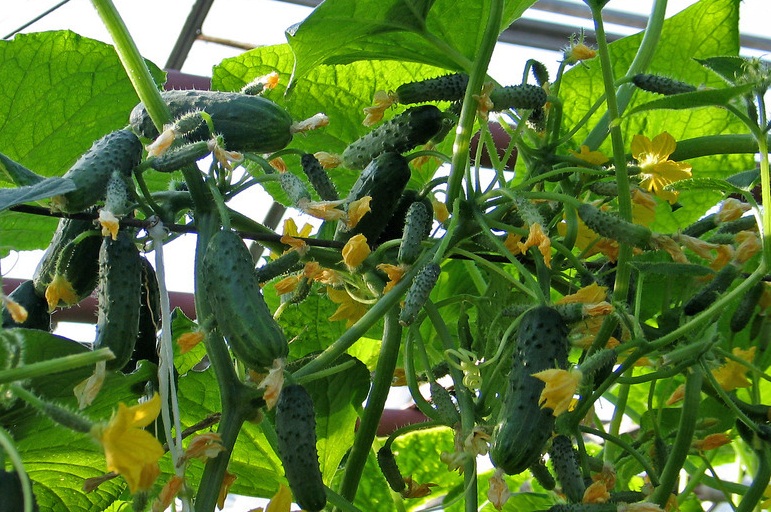
Orpheus F1
Like all very early varieties of cucumbers, “Orpheus” ripens before the fortieth day; after approximately the 38th day after sowing the seeds, 13-centimeter dark green cucumbers with small pimples can be harvested. Their weight varies from 80 to 110 grams.
Friendly family
A very productive medium-ripening variety, resistant to most diseases. On the 45th or 46th day after emergence, the fruits can be harvested. Dense sweet greens reach 12 cm, they are usually canned or pickled. 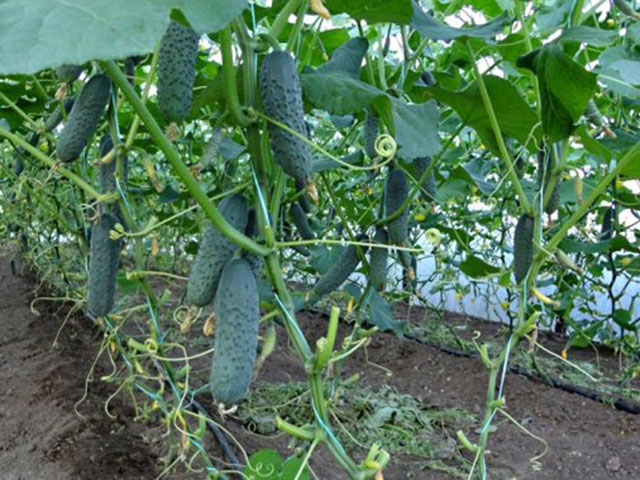
Swallowtail
Hybrid variety for universal use. It does not cause trouble when growing, since it tolerates the vagaries of the weather well, and demonstrates excellent resistance to diseases. One node forms up to 11 ovaries, the greens with barely noticeable pimples quickly gain weight, which reaches 110 g. The strong, surprisingly identical fruits are colored dark green at the stalk and noticeably lighter towards the opposite end, there are longitudinal light stripes along the entire length. They are equally good for salads and canning.
Advance F1
An early-ripening hybrid that grows equally well in a greenhouse and in the garden, only in the garden it requires less attention. It is distinguished by stable fruiting, resistance to powdery mildew and other fungal diseases. The dark green fruits, 10 cm long and 2 cm in diameter, do not form voids in the middle, so they are often canned, but they are also used successfully in summer salads. 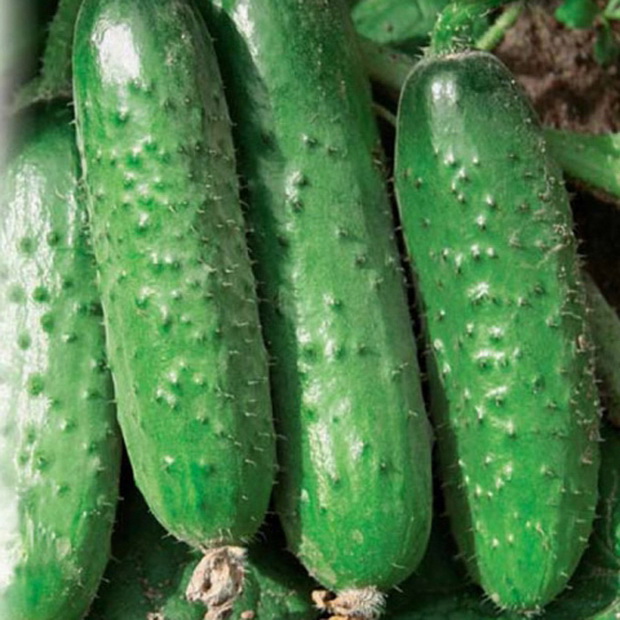
Herman F1
The hybrid of Dutch selection is famous for its early ripening and high yields, and is absolutely not susceptible to fungal diseases. Dark green, pimply fruits grow up to 12 cm long and weigh 90 g. Each node produces from 5 to 9 fruits; they are consumed fresh and salted with equal success.
Cupid F1
Extra early variety with large light green cylindrical fruits. They have a thin skin, almost imperceptible tubercles, dense flesh without bitterness. It is perfectly transportable and is consumed mainly fresh. For processing, mid-season and late varieties are usually used; the earliest ones, even if they are suitable for pickling and canning, are usually eaten fresh. 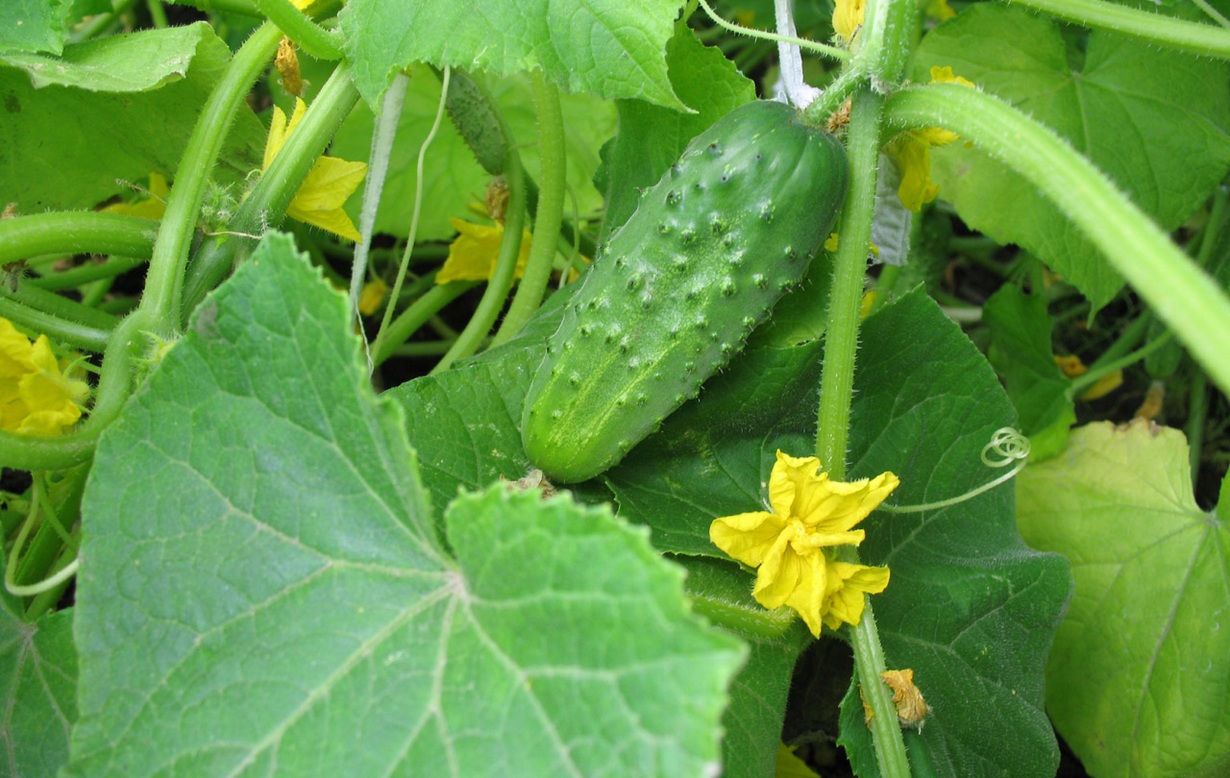
How to grow
Cucumbers grow well in light, fertile neutral soils. Sandy loam or light loamy, non-acidic soils are ideal. They find an open, sunny place and prepare it in the fall. After clearing the area from the previous crop, and best of all, if it was cabbage, tomatoes, onions or even early potatoes, the bed is thoroughly dug up and fertilized. In the fall, it is advisable to apply manure or superphosphate; in the spring, you need to apply not fresh manure, but rotted manure or ammonium nitrate, wood ash. If the soil is acidic, this can be corrected by adding lime or dolomite flour or chalk. 
Cucumber seeds are placed in the soil when it has warmed up to at least +15 degrees. To speed up this process, you can water the bed hot water(even with potassium permanganate), and then cover with film.
Cucumbers are planted in rows or nests, the seeds are buried 2 cm. Experts recommend planting already sprouted seeds; to do this, they are soaked (which allows for the rejection of low-quality ones), and then germinated on damp cotton wool, paper or sawdust. You can use a solution of growth stimulants (“Gumistar” or “Shine-2”).
If the seeds are coated, that is, covered with a thin shell different colors, then they do not need to be prepared for sowing, they have already been processed with everything they need and are covered with a shell of all sorts of useful substances - nutritional, protective and growth-stimulating. Such seeds are increasingly appearing on our market; when purchasing, you should pay attention to the shelf life: seeds are considered normal for up to eight years, but the best germination is for two- or three-year-old seeds.
After planting, the area should be mulched with a layer of two or three centimeters, and then it can also be covered with film or a special material that allows sunlight to pass through; it is permissible to cover it only at night or in case of cold weather.
Early varieties of cucumbers are often planted as seedlings, this will allow you to get the harvest two weeks earlier. Seedlings or seeds can be placed on the garden bed in several stages with an interval of up to 10 days, this will lengthen the time for fruit production and make it permanent. It is better to grow seedlings in separate peat cups, which are then completely placed in a hole in the garden bed - cucumbers do not like their delicate roots being disturbed. IN middle lane the seeds are sown closer to mid-May; if the soil has warmed up to + 18 degrees, then the seedlings can already be planted, but they may still have to be covered at night.
Next, the plants are cared for in the usual way– they are watered, weeded, the soil around them is loosened, fertilizing is applied, and canes are formed. Cucumbers love moisture, but overmoistening the earthen ball can lead to various rots, and periods of drought can make the fruit bitter. Therefore, watering should maintain normal soil moisture - hot weather requires more frequent watering, after rains it is necessary (as after watering) to loosen the soil so that there is always access to fresh air to the roots. The bed must be cleared of weeds in a timely manner; this process is usually combined with loosening, like watering and fertilizing. 
Cucumbers respond well to fertilizing, usually done after two weeks, alternating organic and inorganic fertilizers. They are dissolved with water and applied at the root; water, much less fertilizer, should not get on the leaves. If the plants are growing well and look healthy, you should not get carried away so as not to accumulate all these fertilizers in the fruits. When growth slows, or when the stems and leaves begin to turn pale, you can spray them with a urea solution for a quick effect.
Plants necessarily form by pinching some stems to stimulate the growth of others. To decide how to pinch correctly, you need to know where the ovaries form. In most ordinary varieties, female flowers, and therefore ovaries, are formed on the side shoots, so after the sixth leaf the main stem is pinched, the side shoots are allowed to grow, then they are also pinched to form the required number of side shoots. Up to the sixth leaf of the main stem, as a rule, all ovaries and stepsons are removed. In hybrid varieties, the ovaries are formed on the main stem and close to it, so all the stepsons are removed up to the sixth leaf, then several side ones are allowed to grow at a distance of three to four leaves of the main vine from each other, each of them is pinched after the third leaf. You need to form the plant into one or two main lashes and pinch off the side ones.
![]()
The formation of a plant also depends on the method of its cultivation. More lashes are left “in the spread”; on the trellises, two, maximum three, main lashes are enough. You need to make sure that the plant does not become too dense, remove limp or dried leaves in a timely manner, cut off some healthy leaves if they shade each other. The entire plant must be permeated with fresh air and sunlight, otherwise no resistance built by breeders will save it from diseases.
Svetlana
Not so long ago, only varieties of cucumbers that were pollinated by bees were grown in open ground. These cucumbers have amazing taste and can be salted and pickled. But gradually they began to be replaced by self-pollinating varieties of cucumbers for open ground (parthenocarpics), or self-fertile F1 hybrids. Their fruits can set without pollination by bees. Initially, such varieties were invented for closed greenhouses, but, as it turned out, they give high yields when growing on open plots of land.
Parthenocarpics - self-pollinating cucumber varieties for open ground
These cucumbers have undeniable benefits. Self-fertile hybrids are characterized by extremely high yield and quality of greens. Their fruits have a wonderful taste, without bitterness. Fruiting occurs continuously, and the plant itself is resistant to the most harmful diseases and unfavorable climatic conditions. Considering the fact that bee populations are becoming smaller every year, self-pollinating varieties of cucumbers for open ground have become a real godsend for all gardeners and field growers. In addition, during the period of mass flowering of cucumbers, the weather is often cool, and then gardeners are faced with a problem: there are plenty of flowers, but there is no ovary. Therefore, high-yielding varieties of cucumbers for open ground, self-pollinating, are currently the most in demand in modern vegetable growing.
Hybrid F1 Zador
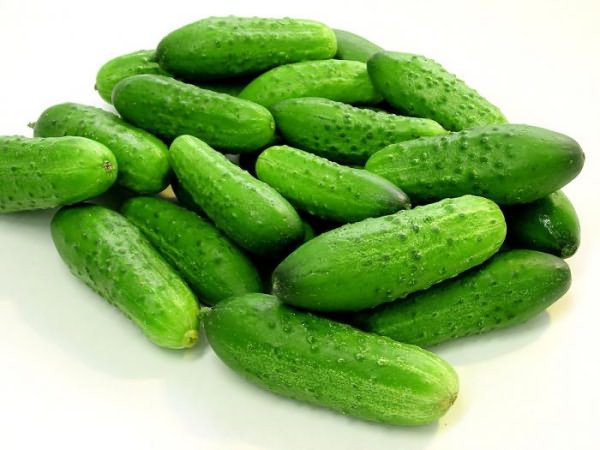
Not long ago, domestic breeders developed a parthenocarpic hybrid, which not only has wonderful taste, but is also perfect for pickling and salting. F1 Zador is classified as a gherkin-type hybrid, in the group “early varieties of self-pollinating cucumbers for open ground.” This species is characterized by high productivity. Cucumber fruits are tasty, without bitterness, dark green in color, with large tubercles and whitish pubescence. The shape of the fruit is cylindrical, up to 10 cm long. These cucumbers are considered the most successful option for pickling. Their skin is quite thin, which facilitates good penetration of salt. There are no seeds in these hybrid cucumbers, so there is no void inside when pickled.
Early varieties of cucumbers, self-pollinating for open ground, Zador, are grown both by direct sowing in open ground and through seedlings. The plant is extremely resistant to disease, rot and bad weather. The stem branches well. The cucumber vines are semi-open, the leaves are medium in size, making it easy to harvest the fruit.
Self-pollinating varieties of cucumbers for open ground F1 Picas

These vegetables are mid-season varieties: it takes about 55 days from germination to fruiting. The plants are very powerful, with a long main shoot. The hybrid has an average shoot-forming ability. These cucumbers can be grown in greenhouses or open ground, after keeping the plants under film for some time. In early May, seedlings can be sown. When two or three true leaves appear, the plant is planted in the ground. This usually happens in May-June. When planting, it is better to use a 40 x 40 pattern.
The fruits are dark green in color, have a cylindrical shape and reach 20 cm with a weight of 180-220 grams. Each node of the plant produces up to three ovaries. The hybrid is quite resistant to rot and powdery mildew. This variety has a high degree of productivity. The taste is excellent. Not suitable for pickling.
Hybrid Rafael F1
Self-pollinating cucumber varieties for open ground F1 Raphael are mid-season hybrid species with a period of 50 days from germination to the start of fruiting. The length of the main shoot can reach 3-3.5 meters, while shoot formation is average.
The hybrid is more suitable for greenhouses, but planting seedlings in the ground is also practiced. Sowing of seedlings can be done in early May, and direct planting in the ground - at the end of the month. The length of the greens reaches 20 cm. The fruits are dark green in color. The taste is high. Up to two ovaries can form in one node. The fruits are not suitable for pickling. The plant is resistant to root rot and various diseases.

White Angel F1
Hybrid White Angel F1 is a mid-season variety with very high degree parthenocarpy (self-pollination). Type of flowering - mixed. The variety is intended for cultivation both in greenhouses and in open ground (subject to the temporary use of protective film).
The plant has a high degree of shoot formation. Up to two ovaries can form in the axils of each leaf. The color of the cucumber is unusual - green-whitish. The fruits reach 8 cm in length and have sparse tubercles. The fruits can be consumed as fresh, either pickled or canned. Productivity from one bush is up to 4 kg.
Caring for self-pollinating hybrid cucumbers
To obtain high seed germination, it is necessary to maintain a temperature of at least 13 degrees Celsius. The ideal temperature for seed germination is 18 degrees at night and 24 during the day.
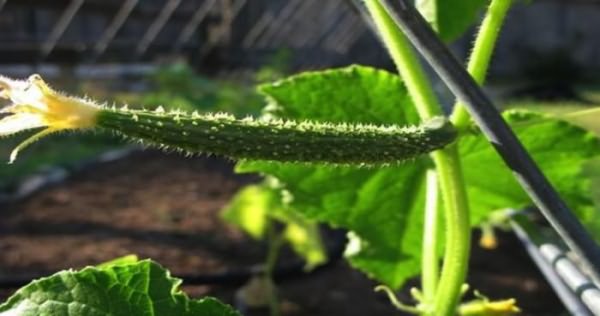
Therefore, high-yielding, self-pollinating varieties of cucumbers for open ground (Rodnichok and other bee-pollinated varieties, similarly) should be sown when the soil warms up well. The bed should be located on the sunny side and be reliably protected from the wind. The sowing is mulched a little with humus, and then covered with film protection to protect the soil from drying out.
When planting seedlings, you can expect a harvest 2-3 weeks earlier than when sowing seeds. When breeding seedlings, it is better to use a special substrate containing high-moor peat in large quantities.
Cucumbers should be fertilized carefully, at the root, using water-soluble mineral fertilizers of low concentration once a week. Water for irrigation should be at room temperature.
fb.ru
Cucumbers - the best varieties for open ground

Currently, the choice of cucumber varieties for open ground is very diverse. Therefore, many gardeners are lost when choosing which variety of cucumbers is best for open ground. When choosing, you should consider the climate in which the cucumbers will grow. Thus, heat-loving varieties will not give a high yield and will not show resistance to diseases when planted in the northern regions. The choice of variety is also influenced by the purpose for which you choose cucumbers. There are varieties for canning and for cutting salads.
Cucumbers are divided into bee-pollinated and self-pollinated, which have a stamen and pistil and can pollinate themselves. They are resistant to changes in air temperature and disease. They are characterized by high yield and good taste.
The most famous varieties of self-pollinating cucumbers:
- "Lapland F1";
- "Boy with Thumb F1";
- "Herman F1";
- "Zozulya";
- "Zador";
- "Orpheus";
- "Alliance".
The best pickling varieties of cucumbers for open ground
Externally, pickling varieties look like plump, short cucumbers. They are ideally suited for conservation. They should be collected before they are fully ripe, before they become hard and inedible. These cucumbers are heat-loving and prefer moderately moist soil. Pickled cucumbers have a crispy taste. The most popular varieties:
- "Competitor";
- "Universal".;
- "Cascade";
- "Aquarius";
- "Far Eastern";
- "Russian taste".
The best varieties of bush cucumbers for open ground
These cucumbers are distinguished by the fact that their vines spread and can reach a length of up to 50 cm.

Almost all varieties are early ripening; the harvest can be harvested during the first three weeks of fruiting. These cucumbers are short in length and are perfect for canning. The most famous varieties include:
- "Baby";
- "Shorty";
- "Baby";
- "Baby";
- “Bush.
You can choose the best varieties of open ground cucumbers for you, depending on the climate in which they will grow and the purpose for which they will be used.
womanadvice.ru
The best self-pollinating varieties of cucumbers for open ground

Cucumber is found everywhere, even in small areas of the dacha or personal plot. The unpretentiousness of the vegetable makes it a desirable guest in the garden beds. There are many varieties of this crop. We present an overview of self-pollinating (parthenocarpic) varieties of cucumbers intended for open ground.
Differences between parthenocarpic cucumbers for open ground
The main difference between this type of favorite agricultural crop is the presence of a female stamen and a male pistil in the flower. Due to this, pollination by insects is not necessary. In view of this, significantly less labor effort is spent on achieving a harvest of such cucumbers compared to greenhouse varieties. And at the same time, they please with good yield indicators, and also have excellent taste characteristics. But they require watering and warmth for their care.
Self-pollinating varieties by ripening time
Early varieties of self-pollinating cucumbers for open ground include:
- Chipmunk F1";
- "Orpheus F1";
- "April F1";
- "Enjoyment F1".
Among the mid-season varieties, “Lapland F1”, “Svyatoslav F1” and “Alliance F1” are popular.
Among the late self-pollinating varieties of cucumbers for open ground, the following are worth mentioning:
- "Kuzya Brownie F1";
- "Phoenix";
- "Crunch F1".
The most productive varieties of cucumbers
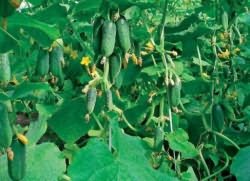
womanadvice.ru
Growing cucumbers in open ground: varieties, features of planting and care - Onwomen.ru
- 7 Harvesting cucumbers
One of the brightest and favorite representatives of many gardeners and gardeners of the pumpkin family is the cucumber. The plant is a vine that roots at the base and grows along any supporting structures, be it a trellis, pegs, boards and other auxiliary materials. The culture is distinguished by large leaves, which are a kind of protection for ripening fruits. By the way, cucumbers themselves can reach up to sixty centimeters in length and up to ten centimeters in diameter. Modern gardeners and gardeners, experiencing a sincere attachment to this culture, have learned to grow cucumbers in any conditions: at home, in a greenhouse and in open ground. Today we will talk about growing cucumbers in the garden.
What varieties of cucumbers are best to grow in open ground?
Of course, not all cucumber varieties are good for growing in open ground.
If a gardener wants to enjoy cucumbers from his plot and does not want to wait a long time for results, it is recommended to choose early-ripening varieties of the crop. The most successful are:
1. "Elegant". Fully lives up to its name. This variety produces very neat fruits, each weighing no more than one hundred and twenty grams. This variety is very good to use in cooking (for cooking fresh salads and other dishes).
2. "Universal". This variety is suitable for pickling and for eating fresh cucumbers. The fruits are finely tuberculate and will delight you with a mild taste.
3. "Altaic"- This is one of the fastest ripening varieties. The harvest can be harvested within 37-40 days after the appearance of the first shoots. The fruits are small and can be used in salads.
Also popular among gardeners are varieties such as "Far Eastern", "Competitor", "Russian taste", "Aquarius".
Hybrid varieties are often sown for open ground. They are able to bear fruit well even in conditions that are not the most favorable for this crop. However, in growing such hybrids (most often the package with seeds will be marked “F1”) there is one “but”: collecting seeds from such plants is useless. Next year, barren flowers will grow from them.
The most popular hybrid varieties for open ground:
1. "Brigantine"– great for pickling. The variety is characterized by stable yield; the taste of the fruit can improve with proper care and timely application of mineral fertilizers to the soil.
2. "Fair Cucumber"– this is one of the sweetest varieties of cucumber culture, it differs early dates planting (beginning of May - for seedlings, beginning of June - in open ground).
3. "Twixie"- This is a universal early ripening variety. It is perfect for pickling and for preparing fresh salads.
4. "Emelya"– blooms according to the female type. The variety is extremely unpretentious to conditions environment, so many people grow it in the conditions of central Russia (it is cold-resistant).
5. "Faithful friends" is an early hybrid variety of cucumbers. It bears fruit very quickly. With proper care, a gardener can get the first harvest of cucumbers a month after the first shoots appear.
Other hybrid varieties of cucumbers are also widespread: “Antoshka”, “Emelya”, “Leader”, “Uhazher”.
After the gardener has decided on the variety of cucumbers, it is necessary to begin choosing a suitable plant for growing this crop.
Choosing a place to grow cucumbers in open ground
If with greenhouse plantings everything is more or less clear: where the greenhouse is located, that’s where we plant cucumbers, then when planting in open ground everything is somewhat more complicated. The gardener needs to take into account three factors: access to fresh air in the area, its illumination, and the history of previous plantings.
You should not plant cucumbers in the place where melons and melons were planted last year: watermelons and melons. Also, you should not overload the same area by growing cucumbers on it every year. It is best if legumes, cabbage or potatoes were grown in this place last year.
If we are talking about the illumination of the area, then cucumbers simply adore the sun's rays. Therefore, it is better to plant the crop in a well-lit place. Although in some areas cucumbers grow well in partial shade. In addition to illumination, one should not forget about free air circulation.
After the gardener has decided on the choice of location and variety of cucumber crop, you can begin preparing the seeds for planting in open ground.
Preparing for planting cucumbers in open ground
Like many other plants, cucumber can be grown in two ways: seedlings and non-seedlings.
With the seedless method, cucumber seeds are immediately planted in open ground. In this case, the seeds can be planted either dry or prepared. But still, many gardeners strongly recommend pre-germinating and hardening the seed material.
Preparing seed material for planting in open ground includes several stages.
The first stage is selection of quality seeds. It is easy to do by placing all the seeds in a saline solution. Seeds that float to the surface of the solution can be discarded. Next you need to cook those that remain at the bottom of the vessel.
The second stage is disinfection of seed material. It is this procedure that protects plants from viruses and bacteria. In most cases, a solution of potassium permanganate is used for disinfection. Cucumber seeds are placed in a weak solution of potassium permanganate for an hour. After this, the seeds are carefully removed and dried.
The third stage is stimulation of seed growth. However, at this stage, many gardeners pre-treat the seeds with special growth stimulants. This allows you to increase the germination rate of plantings. If you don’t have such products at hand, you can use regular baking soda. To do this, dilute the solution: dilute five grams of soda per liter of water. In this solution, the seeds are kept at room temperature (not lower than +20 degrees) for 24 hours. Then the seeds are thoroughly dried and prepared for further processing.
The fourth stage is seed germination. This procedure can be carried out using damp gauze or sawdust. You should carefully spread the seeds on a pre-moistened cloth or damp sawdust, and cover the seeds with another layer of cloth on top. In two to three days, the length of the root will reach half the length of the seed. This is optimal for sowing seeds in open ground.
The second option for growing cucumbers is through seedlings. Today, there are many ways to obtain healthy and viable seedlings. However, they all boil down to one thing simple rule: the duration of the process of growing seedlings should not exceed thirty days.
For seedlings, it is necessary to prepare a nutritious soil mixture. You can purchase it at a flower shop or prepare it yourself. For self-cooking You should mix two parts of humus and peat, as well as one part of sawdust. One seed is sown in each pot. Watering is carried out approximately once a week, exclusively with warm water (not lower than +25 degrees). After a month, the seedlings will be ready for planting in open ground.
Preparing the soil for planting cucumber seeds in open ground
Preparing the soil for planting cucumbers can be done in spring or autumn. It all depends on the efforts of the gardener himself. When it comes to preparing for the fall, experienced gardeners strive to enrich the soil with fertilizers. One of possible options is to apply at least seventy grams of classic mineral fertilizer – nitrophosk – per square meter. You should also add three buckets of manure and two to three glasses of wood ash. This nutrient mixture remains to winter until the onset of the spring thaw. In spring, the soil is dug up to a depth of twenty to thirty centimeters. Next, you can form beds for future plantings.
If the gardener did not have time to prepare the land for planting cucumbers, then this can be done in the spring. Preparations begin approximately two weeks before planting begins. Manure is added to the soil. You need to wait until the soil is enriched with nutrients and then enrich the soil with organic fertilizers. Many gardeners recommend “warming up” the soil. It is believed that this will allow future plantings to quickly take root in a new location. Before you begin to form beds for sowing cucumbers, it is recommended to sprinkle a fifteen-centimeter layer of fertile soil on top. On the sides of the beds special borders for watering are formed. This completes the preparation of the soil. You can start planting cucumbers in open ground.
Planting cucumbers in open ground
The time for planting cucumber seeds in open ground occurs in the first half of May. Seedlings can be planted a little later. In the pre-dug bed, grooves are formed, the distance between which should be at least fifteen centimeters. The seeds themselves should be planted to a depth of no more than one and a half centimeters. The distance between plantings should be at least fifteen centimeters. If we are talking about seedlings, then the distance between plantings should be at least twenty centimeters. Young plants should under no circumstances shade each other. This completes the planting of cucumbers. But that's only half the battle. The most important component of success is proper cultivation of cucumbers in open ground.
Proper care of plantings in open ground
Watering
If in greenhouse conditions a gardener can control the watering regime, then when growing in open ground conditions the situation is somewhat more complicated. If the summer was sunny and not too hot, but normal mode watering - once every six days. If the summer months are rainy, then the plantings, on the contrary, need to be protected from waterlogging. Many gardeners form grooves around the perimeter of the site where excess water flows.
Top dressing
Cucumber plantings need to be fertilized regularly, starting from the very moment the plants are planted in open ground. This can be done using complex mineral fertilizers. There is a market a large number of various types dressings: “Agricola”, “Diammofoska”, “Ammofos”, “MASTER” and others. Plants are fed according to a specific schedule. The first feeding is applied fifteen days after planting, the second - at the beginning of flowering, the third - during the growing season and the fourth - during the period of mass fruiting. Approximately a month before harvesting the fruits, fertilizing should be stopped.
Weeding and loosening
Don't forget about regular weed control. Cucumber plantings really don’t like it when they have to share their supply of nutrients with other plants. Therefore, plantings should be weeded regularly, ridding young plants of unwanted proximity to weeds.
Loosening is one of the most important components of proper care of cucumber plantings. This procedure is recommended to be performed after rain or regular watering. There are situations when cucumber plantings develop roots on the surface. In this case, it is necessary to add two to three centimeters of fertile soil. In total, during the growing period, an additional layer of fertile soil is added two or even three times.
Harvesting cucumbers
As the cucumbers form, you can begin to slowly collect them. It is not worth keeping the fruits on the plant too long, as this leads to a decrease in the yield of cucumber plantings. The fact is that such a seed fruit consumes a lot of nutrients. This supply would be enough to form at least three, or even four new fruits. You need to pick cucumbers carefully so as not to damage the new ovaries. For pickling, it is preferable to use medium and small greens.
Growing cucumbers in open ground is a troublesome, but also very interesting activity.
The gardener’s efforts will be rewarded with sweet and juicy cucumbers on the dining table, as well as delicious preparations for the winter.
When selecting cucumber seeds for future planting, many characteristics are taken into account: ripening time, growing conditions, fertility. Another important factor, without which it is impossible to get a good harvest, is the form of pollination.
 According to the method of fruit set, there are three types of this vegetable crop: insect-pollinated, parthenocarpic and self-pollinating.
According to the method of fruit set, there are three types of this vegetable crop: insect-pollinated, parthenocarpic and self-pollinating.
The first option is to cross-exchange flower pollen with the help of bees, bumblebees, butterflies and other hymenoptera.
In the second and third cases, winged pollinators are not needed. Parthenocarpic fruits are not pollinated at all and do not contain full seeds in the pulp. need pollination, but it occurs due to the special structure of the bisexual flower. Pollen is transferred from the anthers to the stigma of its own pistil or neighboring flowers of the same plant.
Advantages of self-pollinating varieties
 Cucumbers that do not require cross-pollination are ideal for greenhouses. In such garden structures, the possibility of bees entering is limited, so the amount of fruit produced is significantly reduced.
Cucumbers that do not require cross-pollination are ideal for greenhouses. In such garden structures, the possibility of bees entering is limited, so the amount of fruit produced is significantly reduced.
For unprotected soil, varieties that set fruit on their own are also good. By choosing this type of plant, you don’t have to worry about the future harvest. After all, greens will form under any conditions and regardless of the weather.
The best varieties of cucumbers that do not require pollination
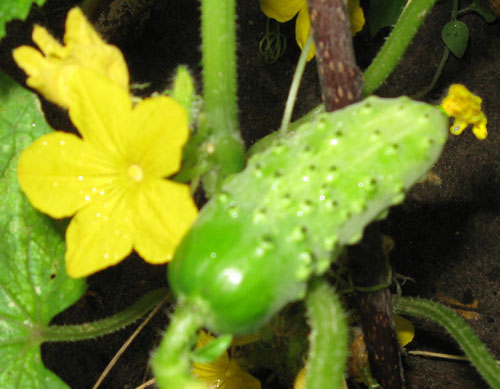 When choosing seeds of self-pollinating cucumbers for open ground, you must pay attention to the peculiarities of cultivation of a particular species. If it is intended exclusively for greenhouse structures, then this variety will not be suitable for unprotected soil.
When choosing seeds of self-pollinating cucumbers for open ground, you must pay attention to the peculiarities of cultivation of a particular species. If it is intended exclusively for greenhouse structures, then this variety will not be suitable for unprotected soil.
Mullet variety F1
 This variety has virtually no disadvantages. This is confirmed by reviews of the Mullet f1 cucumber, which speak of its versatility in cultivation and use. The variety is early ripening, the fruits appear 45-48 days after the start of active growing season. It belongs to the parthenocarpic varieties and can grow both in protected soil and without greenhouse shelters. Suitable for cultivation in all regions of the country. It is characterized by long fruiting – 60 days or more.
This variety has virtually no disadvantages. This is confirmed by reviews of the Mullet f1 cucumber, which speak of its versatility in cultivation and use. The variety is early ripening, the fruits appear 45-48 days after the start of active growing season. It belongs to the parthenocarpic varieties and can grow both in protected soil and without greenhouse shelters. Suitable for cultivation in all regions of the country. It is characterized by long fruiting – 60 days or more.
By type of fruit - gherkin cucumber. The ovaries are formed in bunches of 8-10 (sometimes 12) pieces. This feature significantly increases productivity. During the first 30 days, you can harvest about 6 kg of vegetables from a bush, and the total yield from 1 sq.m. - up to 12 kg.
Variety Harmonist F1
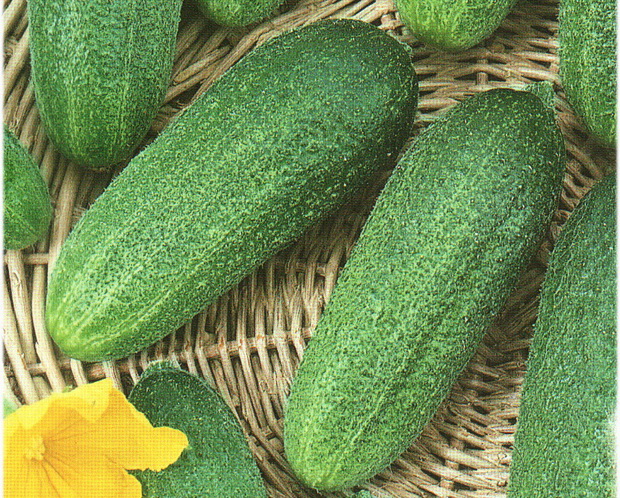 No less commendable reviews about the Harmonist F1 cucumber can be found on the websites and forums of gardeners and gardeners.
No less commendable reviews about the Harmonist F1 cucumber can be found on the websites and forums of gardeners and gardeners.
An early ripening hybrid - the growing season is 40 days. Designed for any growing conditions: greenhouse, greenhouse, uncovered soil. The type of flowering is female, the method of fruit set is parthenocarpic. An average of 6 cucumbers are tied in each leaf axil. All of them are uniform in shape, weight and color. The shape is cylindrical, the weight of each fruit is 90-100 g. The color is bright green at the base, whitish at the top. The skin is densely covered with small tubercles. The taste is sweet, there is no bitterness, the seeds are practically not felt. The variety gives a good yield of vegetables - up to 13 kg/sq.m.
Variety Vyatsky F1
The goal of breeding the Vyatsky F1 cucumber was to obtain a plant that could easily tolerate poor soil composition, sudden drops in temperature, irregular watering, pest attacks and had good immunity against most diseases.
 The cultivation results should not have depended on the cultivation method. With or without a greenhouse, it should consistently produce a bountiful harvest.
The cultivation results should not have depended on the cultivation method. With or without a greenhouse, it should consistently produce a bountiful harvest.
Breeders managed to combine all of the listed requirements in one variety, as evidenced by reviews of the Vyatsky f1 cucumber on the Internet.
In addition to all the listed advantages, this hybrid is characterized by other positive qualities: early ripening (about 30 days), female type of flowering, ease of care, versatility of fruit use.
Cucumber variety - medium size (120g/12cm), cylindrical, green, tuberous. The pulp is without cavities, juicy, delicate in taste.
Variety Grasshopper F1
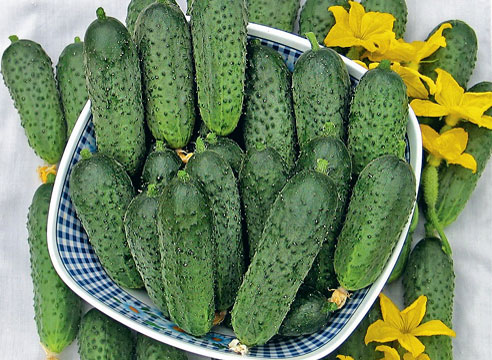 Quite good reviews about the Grasshopper f1 cucumber recommend growing this cucumber in open garden plots. He sets fruits in bunches of 2-6 pieces. Cucumbers are green, bordered by faintly colored stripes, the tubercles are large, with white spines. The weight of one vegetable is 100 g, length is 11-12 cm. The yield is high: one square meter with plantings yields from 10 to 13 kg of fruit. Good immunity to all diseases except peronosporosis. The variety fights this “disease” with varying success.
Quite good reviews about the Grasshopper f1 cucumber recommend growing this cucumber in open garden plots. He sets fruits in bunches of 2-6 pieces. Cucumbers are green, bordered by faintly colored stripes, the tubercles are large, with white spines. The weight of one vegetable is 100 g, length is 11-12 cm. The yield is high: one square meter with plantings yields from 10 to 13 kg of fruit. Good immunity to all diseases except peronosporosis. The variety fights this “disease” with varying success.
Variety Patti F1
 After reading the reviews about the Patti f1 cucumber, you can come to the conclusion that it is one of the most suitable for our conditions. Wherever he is planted, he will demonstrate good results everywhere. Greenhouse, open land, loggia and even window sill - all these conditions are suitable for an unpretentious hybrid. In terms of harvest timing, it belongs to the mid-early harvest. The period from the first shoots to the first harvest takes from 40 to 44 days.
After reading the reviews about the Patti f1 cucumber, you can come to the conclusion that it is one of the most suitable for our conditions. Wherever he is planted, he will demonstrate good results everywhere. Greenhouse, open land, loggia and even window sill - all these conditions are suitable for an unpretentious hybrid. In terms of harvest timing, it belongs to the mid-early harvest. The period from the first shoots to the first harvest takes from 40 to 44 days.
Blooms mostly female flowers, parthenocarpic, ovaries collected in bunches. Cucumbers are medium-sized, weighing 50-90 grams each. The skin is thin, dark, green, with small stripes, covered with very small and frequent tubercles. The pulp is crunchy, contains a small amount of seeds, and tastes sweet. The main advantages of the variety are good transportability of fruits, high yield and drought resistance.
Variety Taganay F1
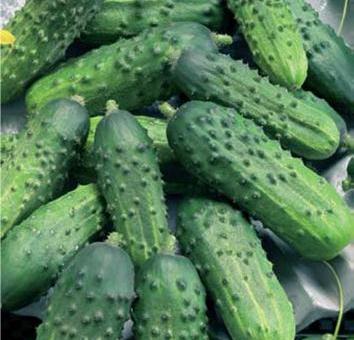 Thanks to its tolerance to the harshest climatic conditions, reviews of Taganay f1 cucumbers are full of grateful responses. The variety was bred in the Urals, so it passed all the necessary tests for resistance to unfavorable growing conditions. It is suitable not only for cultivation on Siberian and Ural lands, but also for most other cool regions.
Thanks to its tolerance to the harshest climatic conditions, reviews of Taganay f1 cucumbers are full of grateful responses. The variety was bred in the Urals, so it passed all the necessary tests for resistance to unfavorable growing conditions. It is suitable not only for cultivation on Siberian and Ural lands, but also for most other cool regions.
This variety is valued not only for its ability to bear fruit in rainy and dry weather. Introducing self-pollinating varieties of cucumbers for open ground, he forms bouquet ovaries that are guaranteed to produce an abundant and high-quality harvest of gherkin-type fruits. By following all the necessary rules of agricultural technology, you can get up to 30 kg of products from one plant. Moreover, this will happen in an extremely short time, because the vegetables will ripen in about 36 days.
The fruits of the Taganay F1 variety are cylindrical, length – 8-10 cm, “bouquets” of several pieces are tied. The taste is excellent, transportability is good.
Variety Bogatyrskaya sila F1
 Good reviews of the cucumber Bogatyrskaya sila f1 can be heard from farmers who prefer to grow productive, bunch varieties without shelter. The variety is characterized by bouquet ovaries. Each bunch contains from 2 to 8 greens, sometimes more. Cucumbers are medium in size, weighing 110-130 g, length 8-12 cm. The shape of the fruit is cylindrical, pubescence is medium. The flesh is crispy, dense, sweet and juicy.
Good reviews of the cucumber Bogatyrskaya sila f1 can be heard from farmers who prefer to grow productive, bunch varieties without shelter. The variety is characterized by bouquet ovaries. Each bunch contains from 2 to 8 greens, sometimes more. Cucumbers are medium in size, weighing 110-130 g, length 8-12 cm. The shape of the fruit is cylindrical, pubescence is medium. The flesh is crispy, dense, sweet and juicy.
The variety is resistant to most diseases. The peculiarity is the need to constantly collect cucumbers. If this is not done, the quality and quantity of the harvest decreases.
Variety Primadonna F1
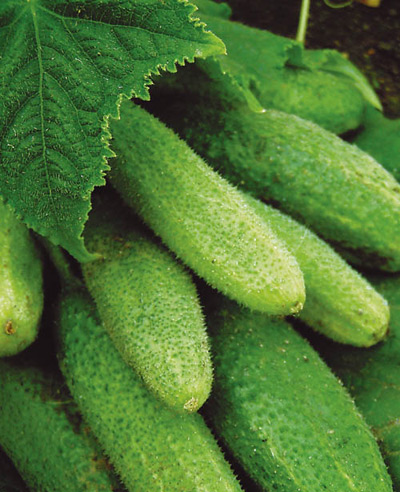 The Primadonna variety, bred by domestic breeders, is suitable for any growing conditions. It blooms predominantly with female flowers. Afterwards, bunches of ovaries appear in the nodes. They contain from 3 to 9 gherkins. The fruits are small: average weight - 100 g, length - 11 cm.
The Primadonna variety, bred by domestic breeders, is suitable for any growing conditions. It blooms predominantly with female flowers. Afterwards, bunches of ovaries appear in the nodes. They contain from 3 to 9 gherkins. The fruits are small: average weight - 100 g, length - 11 cm.
This hybrid is distinguished by early ripeness (vegetation period - 36-45 days) and long fruiting. Productivity is high, up to 25 kg/sq.m. It has good immunity to most diseases and does not suffer from sudden temperature changes.
Regarding taste, reviews of the Primadonna cucumber variety claim that the fruit pulp is dense, without empty chambers. The taste is sweet, without bitterness, the aroma is very delicate and fresh.
Variety Espagnolette F1
 Most reviews of the Espagnolette f1 cucumber recommend it as “the crispiest.” Indeed, even after pickling, vegetables do not lose their “crackiness”. A medium-ripening variety, the first fruits can be seen on the cane 55 days after the first leaves appear. They are collected in neat bouquets of 3 pieces. Zelentsy are medium-sized: they weigh about 85 grams, reach 10-11 cm in length. They are rich green in color, literally dotted with small tubercles, on which barely noticeable white thorns “flaunt”. These cucumbers have an excellent taste: sweet, juicy, crispy and tender - they will not leave anyone indifferent.
Most reviews of the Espagnolette f1 cucumber recommend it as “the crispiest.” Indeed, even after pickling, vegetables do not lose their “crackiness”. A medium-ripening variety, the first fruits can be seen on the cane 55 days after the first leaves appear. They are collected in neat bouquets of 3 pieces. Zelentsy are medium-sized: they weigh about 85 grams, reach 10-11 cm in length. They are rich green in color, literally dotted with small tubercles, on which barely noticeable white thorns “flaunt”. These cucumbers have an excellent taste: sweet, juicy, crispy and tender - they will not leave anyone indifferent.
Variety Lyutoyar F1
 If you set a goal and find out which of the self-pollinating varieties gives a stable harvest long time, then reviews of the Lyutoyar f1 cucumber left by lovers of this vegetable will help here too.
If you set a goal and find out which of the self-pollinating varieties gives a stable harvest long time, then reviews of the Lyutoyar f1 cucumber left by lovers of this vegetable will help here too.
The variety was bred in Turkey and is characterized by resistance to stress associated with temperature changes, drought, diseases and pests. The peculiarity of the hybrid is long-term fruiting and the ability to produce a crop twice a season.
Cucumbers are arranged 2-3 pieces in a node. Painted dark green. Very lumpy, with prickly white spines. There are no voids or bitterness in the pulp. An excellent variety for transportation and cultivation for commercial purposes.
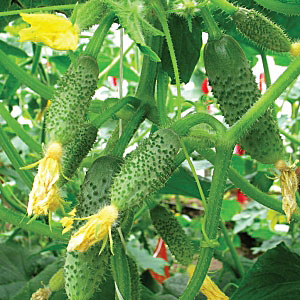 Variety Merry Company F1
Variety Merry Company F1
The highest award for the most beautiful fruits and decorativeness of the bush could go to the Merry Company f1 variety. This plant belongs to the gherkin variety. The cucumbers are beautiful, regular cylindrical in shape, small (8 -10 cm/80 g). The peel is juicy green, medium lumpy, white pubescence. Almost all reviews about the Veselaya Kompaniya F1 cucumber confirm their amazingly delicate and juicy taste. The fertility of the hybrid is also at a height of 9.5 kg/sq.m.
Variety Podmoskovnye Vechery F1
Another self-pollinating variety is generating positive reviews about the Podmoskovnye Evenings f1 cucumber among gardeners. The variety is bunched, early ripening, shade-tolerant, fertile. Zelentsy weigh 90-100 grams, their length is 11-13 cm. The shape is cylindrical, the peel is not very covered with tubercles. Productivity is excellent - from 15.5 kg/sq.m.

Cucumbers Moscow Evenings F1
Variety Mazai F1
One of the fastest ripening among parthenocarpic cucumbers - these are the reviews about the Mazai f1 cucumber that are most often heard about it. He loves light and is resistant to almost all diseases. Forms 2-3 ovaries in one node. The fruits are gherkin, the tuberosity is inexpressive, the pubescence is average. Cucumber weight – 80-100 g, length – 13 cm. On average, the total weight of fruits obtained from 1 sq.m. is 13 kg.
Variety Vyuga F1
 The earliest varieties with similar characteristics include the Vyuga F1 variety, obtained by St. Petersburg breeders. Many reviews about the Vyuga f1 cucumber talk about its ability to grow in width after the fruit reaches a length of 5.5-6 cm. Such cylindrical barrels with tubercles make the variety especially attractive in appearance.
The earliest varieties with similar characteristics include the Vyuga F1 variety, obtained by St. Petersburg breeders. Many reviews about the Vyuga f1 cucumber talk about its ability to grow in width after the fruit reaches a length of 5.5-6 cm. Such cylindrical barrels with tubercles make the variety especially attractive in appearance.
Variety Beijing gourmet F1
The most unusual - such reviews about the Beijing Gourmet f1 cucumber can be found on almost every gardening forum. All thanks to the shape of the fruit: unusually elongated (≈35-40 cm), dark green (almost black), densely strewn with tubercles, they amaze with their appearance and unusually sweet, almost dessert taste. This variety is used mainly for making fresh salads.
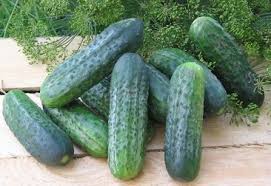 Variety Alekseich F1
Variety Alekseich F1
The favorable reviews about the Alekseich f1 cucumber are justified by beautiful, cylindrical cucumbers 6-8 cm in length, weighing about 60 grams. They are not bitter at all, and their crust has practically no tubercles or sharp thorns. Such bunched cucumbers give a good harvest - 12-14 kg. Very early variety: the growing season lasts only 38-42 days.
Variety Christina F1
A distinctive feature of the Christina f1 variety is good transportability, resistance to many diseases and drought. Basically, growing the Christina f1 cucumber in open ground does not require much effort, and its parthenocarpic nature allows you to get good yields. The fruits are small - 80-110 g, taste - high.
Asterix F1 - bee-pollinated variety
If, nevertheless, the farmer decides to grow varieties with classic cross-pollination, then the Dutch variety Asterix F1 is perfect for this purpose.
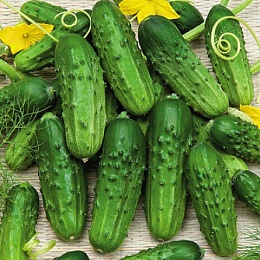 True, it is not recommended for all areas. It is best to grow it without greenhouses in the central regions of Russia.
True, it is not recommended for all areas. It is best to grow it without greenhouses in the central regions of Russia.
By consulting the opinions of others via the Internet, you can find out reviews about the Asterix f1 cucumber as the best variety for mass cultivation for sale. This popularity is explained by the fact that it is a very hardy hybrid. He doesn’t mind drought, he has complex disease resistance, and the yield is decent. In addition, its fruits are of standard size, attractive in appearance and have excellent taste. A medium-sized cucumber: weight – 80 g, length – 11 cm. Lumpiness – moderate, spines infrequent, white. The skin is green with small and faint stripes. The pulp is juicy, dense, crispy, not bitter. Suitable for all types of processing and fresh consumption.



















